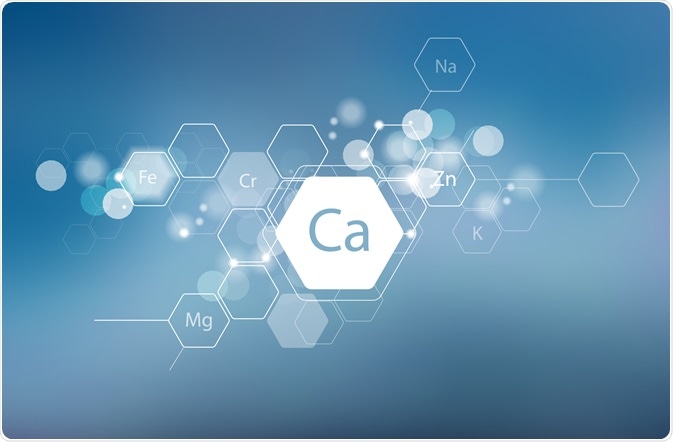Bioinorganic chemistry is a field that focuses on the biochemistry of inorganic elements and compounds. This includes the dynamics of metal ions in living systems, the function of metalloproteins, and the application of inorganic medicines.
Organic molecules are those that possess carbon-hydrogen bonds, which thus make up the majority of the biomolecules in living creatures. The majority of carbon and nitrogen in living animals is bound in organic protein, lipid, and carbohydrate compounds, with most oxygen and hydrogen in water. The next most common elements in living creatures include the inorganic elements calcium, sodium, chlorine, potassium, phosphorus, and sulfur, which play various roles in the fulfillment of cellular functions and homeostasis.
Calcium, for example, acts as an electrolyte that is essential in muscle contraction and nerve signaling, besides also composing the bones and teeth, while phosphorous provides the phosphate ion (PO43-), a key component of DNA, RNA, phospholipids, and the energy transfer molecule adenosine 5'-triphosphate (ATP).

Image Credit: Sadovnikova Olga/Shutterstock.com
Metal homeostasis
Many metal ions are essential to life, while others are highly toxic even in minimal concentrations, in some cases depending on species. Transition metals such as copper and iron participate in the generation of reactive oxygen species by electron transfer, which can go on to damage local biomolecules and induce cell death. However, copper and iron are essential to many cellular processes, and thus various cellular mechanisms have evolved to maintain homeostasis.
In yeast, the superoxide dismutase enzyme provides a defense against oxidative stress by catalyzing the generation of hydrogen peroxide from superoxide radicals. Copper is transported across the cell membrane by high or low-affinity transporters, with their activity modulated by extracellular copper concentrations, being enhanced in low-copper conditions.
Similarly, iron is transported into yeast as ions or in compounds via specific and non-specific membrane transporter proteins. Interestingly, copper is required for iron homeostasis in yeast, as these iron-chelating transporters are copper-containing metalloproteins.
Metalloproteins
The totality of metal and metal-containing biomolecules in a cell is termed the metallome, traditionally referring to the dynamics of metal ions and their homeostasis, but also including metalloproteins. As much as half of all proteins in nature contain a metal, with a large proportion requiring metals to fulfill their function. The most common metals in proteins are magnesium, zinc, iron, and manganese, where they are utilized for their chelating properties and participation in redox reactions.
Likely the earliest recognized metalloprotein was hemoglobin, where iron was first identified in the blood in the early 18th century by Lemery and Geoffroy, who burned blood to ash and observed magnetic particles within. During the 1950s and 60s, x-ray structures of proteins were being widely published, including the first clear image of the positioning of iron in hemoglobin.
The hemoglobin biomolecule bears four subunits in a circular arrangement, each containing a single heme group that contributes towards bonding with a central Fe2+ ion. Prior to bonding with molecular oxygen, the ion rests below the plane of the relaxed porphyrin ring, while upon bonding with oxygen the now Fe3+ ion is pulled up into the plane of the now tense ring.
Zinc has been known to be essential to eukaryotes since the mid-19th century, being recognized as a constituent of some enzymes since the 1940s and 50s. Zinc plays several structural and functional roles in proteins, acting to stabilize folded protein structures, often in the form of a structural protein motif known as a zinc finger. Zinc finger motifs fine-tune the binding specificity of proteins and are heavily employed during transcription, translation, and mRNA trafficking, among many other applications.
Inorganic medicines
Inorganic medicines have been utilized by humans for thousands of years, with ancient Egyptian medical texts describing the use of copper to sterilize water and wounds. One of the earliest modern inorganic medicines were organoarsenic compounds, developed by German physician Paul Ehrlich in 1909 for the treatment of syphilis.
Arguably the most successful inorganic medicine developed may be the common chemotherapeutic drug cisplatin and its derivatives, described in 1845 and is known as Peyrone’s salt at the time. The structure of cisplatin was later elucidated by Alfred Werner in 1893, and the cytotoxic properties of the drug were explored by Barnett Rosenberg in 1965. It was noted that only the cis isomer demonstrated cytotoxic activity, with the square planar Pt2+ form of the complex being more cytotoxic than the octahedral complex.
Cisplatin was later applied to rats bearing sarcomas where it was shown to be highly effective in preferentially targeting quickly dividing cells as seen in cancer, and was quickly approved by the FDA in 1978 for use against ovarian and testicular cancers, the latter seeing survival rates increase from prior levels of only 10% to 85%.
Nanomaterials sit in an interesting size regime with regards to interactions with biomolecules, bearing a comparable diameter to proteins they are thus able to enter cells and engage with cellular machinery. The behavior of nanomaterials constructed from metals in vivo and in vitro is, therefore, the concern of bioinorganic chemists, with applications ranging from antimicrobial coatings on high-contact surfaces, medical devices, and wound dressings, to the use and nanoparticles as therapeutic and diagnostic tools in the clinic.
References:
Further Reading